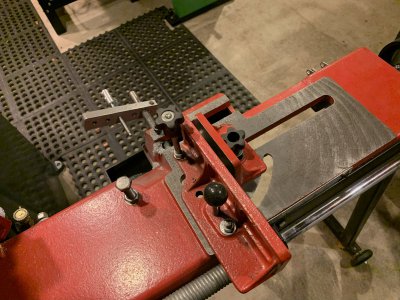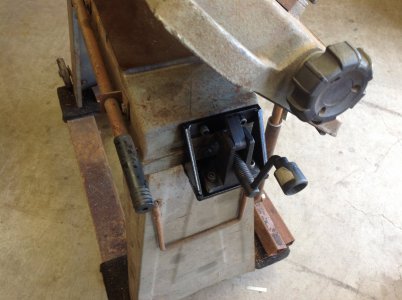I inherited my 4x6 saw (1981 Taiwan-made "Detroit Machinery" but pretty much the same as the HF, Jet, etc.) from my Dad, and the primary jaw, the one on the right, has a standard 9/16" bolt which tightens below the deck with a standard nut and a somewhat bent flat washer. I'm thinking this is not the OEM setup, or if it is, improvement is needed. Tightening involves reaching under the saw deck and holding the nut whilst tightening the bolt. I'm not happy with this arrangement, and was wondering about the correct setup (T-nut?) or a mod that would allow tightening without a backup. Thanks for your suggestions.
-
Welcome back Guest! Did you know you can mentor other members here at H-M? If not, please check out our Relaunch of Hobby Machinist Mentoring Program!
You are using an out of date browser. It may not display this or other websites correctly.
You should upgrade or use an alternative browser.
You should upgrade or use an alternative browser.
Jaw fastener
- Thread starter MrEarl
- Start date
- Joined
- Sep 5, 2013
- Messages
- 3,207
It appears mine is still like that as well. I’ve modified all the other fixin’ points there so they’re easier to adjust but that one is still the lame factory deal.
I always wanted to replace it with a T-nut but it’s the curve that makes it tough. On mine the arc of the slot doesn’t seem to follow the pivot point exactly (it’s a little off, I think) so whatever fastener has to be loose enough to shift around a little when I swing the jaw (fortunately not often). I’m sure it’s not insurmountable, just more trouble than I was willing to invest when I rebuilt the saw.

I always wanted to replace it with a T-nut but it’s the curve that makes it tough. On mine the arc of the slot doesn’t seem to follow the pivot point exactly (it’s a little off, I think) so whatever fastener has to be loose enough to shift around a little when I swing the jaw (fortunately not often). I’m sure it’s not insurmountable, just more trouble than I was willing to invest when I rebuilt the saw.

- Joined
- Feb 9, 2017
- Messages
- 5,253
Yup, the original setup is goofy at best and downright stupid at worst. I’ve owned mine since ‘78 and just always put up with it. Then a couple of years ago and engineer from Rong Fu one of the original makers in Taiwan joined here and started asking questions about how to make a better 4x6. This got me thinking and I got inspired as I was using the saw a lot for a door frame and doing a lot of mitre cuts.
What I decided to do was make the pivot just a stud and turned a stand-off on the lathe to elevate the nut above the height of the vise so it was easy to get to. The other I used a carriage head bolt that fit the slot so it could be adjusted just from the nut on top and also made a stand off for it too. This way they could both be adjusted with just wrench that stays on the saw on a magnet. If I remember there was some messing with the mitre slot to get it to work smooth. Something it had never done. I also replaced the vise mechanism with a quick release type I found in a garage sale probably off an abrasive saw.
Wish I would have done this decades ago but not until the thread here did actual solutions come to me. And without that, if it ain’t totally broke, I ain’t got time.
What I decided to do was make the pivot just a stud and turned a stand-off on the lathe to elevate the nut above the height of the vise so it was easy to get to. The other I used a carriage head bolt that fit the slot so it could be adjusted just from the nut on top and also made a stand off for it too. This way they could both be adjusted with just wrench that stays on the saw on a magnet. If I remember there was some messing with the mitre slot to get it to work smooth. Something it had never done. I also replaced the vise mechanism with a quick release type I found in a garage sale probably off an abrasive saw.
Wish I would have done this decades ago but not until the thread here did actual solutions come to me. And without that, if it ain’t totally broke, I ain’t got time.
Attachments
- Joined
- Feb 1, 2015
- Messages
- 9,622
A 7/16" tee nut will work but there may be some interference with the casting when the fence is at a 90º position. Some work with a die grinder and a carbide burr could remedy that. Tee nut have an unfinished thread or punch mark to prevent a bolt from passing completely through and that will have to be addressed bu either retapping the nut or using a shorter bolt.
- Joined
- Feb 1, 2015
- Messages
- 9,622
For the pivot bolt, tap it for the next larger size thread and enlarge the hole in the fence to suit. Here are some other mods that I made to mine.

 www.hobby-machinist.com
www.hobby-machinist.com

Useful 4x6 Mods.
My 4x6 bandsaw actually can only cut a 5" wide piece due to the placement of the front vise jaw. I replaced the front jaw with a 6" length of 3/4" x 3/4" hot rolled bar and gained an extra 1-1/4" of capacity. The bar is mounted with two 5/16-18 socket head cap screws in two new threaded holes...
 www.hobby-machinist.com
www.hobby-machinist.com




